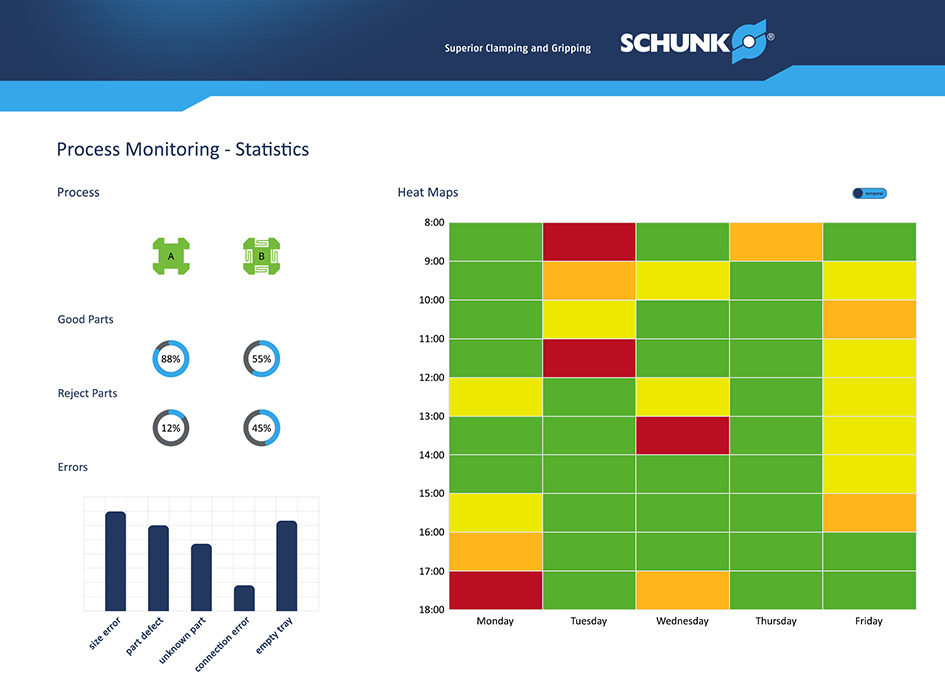Intelligent grippers take over handling, condition monitoring, and parts of operational process management
“Closest-to-the-part” is how SCHUNK describes the exposed position of its grippers in the handling process. SCHUNK uses this advantage to develop intelligent modules that can do much more than conventional pick & place. As “smart gripping” solutions, intelligent grippers such as the SCHUNK EGL Profinet enable autonomous handling scenarios. They measure, identify and monitor gripped components and the ongoing production process in real-time. The information recorded by the gripper is passed on to the machine control system and can be simultaneously transferred to higher-level internal and external systems as well as cloud solutions for statistical process analyses.
Whereas conventional handling solutions have primarily focused on the process stability and cost-effectiveness of individual operations, modern applications are increasingly enabling a more flexible process chain while at the same time providing detailed process data. This is SCHUNK’s aim. In other words, the gripper itself detects a faulty component without additional external sensors and decides whether the part should be ejected from the process. If a component is gripped before and after a process step and there is an accumulation of NOK parts, a digital service uses the knowledge of the gripper to automatically analyze whether the fault was already present or whether process changes in the upstream station might have caused the damage to the component.
Grippers become enablers for intelligent handling processes
SCHUNK illustrates how this can be accomplished using the example of a high-speed depaneling system from its subsidiary SCHUNK Electronic Solutions. The system separates small electronic circuit boards from a carrier plate called a panel. After they are separated, the “free” circuit boards are gripped and placed in their destination (e.g. a load carrier) by means of an axis system. Before the components are placed, they are usually measured and checked for quality. For this handling step, SCHUNK now uses an intelligent gripper, which has built-in sensors / functions for measuring and inspecting the quality of components during the gripping process. The measured data and information derived from it are passed on to the plant cell control system for further process control. The gripper sends the data not only to the cell control system, but also to an analysis tool on the HANA SAP Cloud. The tool continuously collects all data relevant for process optimization. The SAP HANA platform allows the operator of the system to monitor conditions in real-time on devices such as screens or smart phones. Each gripping process has to be tracked live, the results have to be statistically evaluated and visualized, and actions such as process improvements have to be deduced and initiated. The built-in quality control and the automatic ejection of defective components based on individually definable set points prevents defective printed circuit boards from being refined further in the subsequent process steps at a high cost. At the same time, the need for costly measuring systems and evaluation units as well their connection and configuration is eliminated. The measurements and tests integrated into the handling process also eliminate the cycle time required for external inspections and makes the process faster and more cost-effective.
Smart gripping
With the concept of “smart gripping,” SCHUNK expands the possibilities of cells to enable functionally integrated, highly networked handling. The key component is the smart SCHUNK EGL Profinet parallel gripper. Its certified Profinet interface and integrated electronics provide optimal conditions for such applications. With a variable stroke and a variable gripping force between 50 N and 600 N, the gripper covers an extremely wide range of components. In a smart gripping process, the intelligent gripper uses its exposed position directly on the part. Using built-in sensors, it captures the data of the component as well as its size and elasticity. This data is processed in the gripper, making it possible to identify components, detect damage, and decide whether the component is good or bad. After processing, both the recorded information (e.g. good or bad component) as well as the measured data can be transferred via the Profinet interface to the plant control system for process control. This data may in turn be located on the company’s own server or in an external location.





